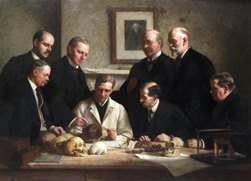Geologist and science writer Nina Morgan sifts through the evidence behind the biggest fossil hoax of the 20th Century
 On 18 December 1912 Arthur Smith Woodward [1864 – 1944], a distinguished palaeontologist and Keeper of Geology at what is now the Natural History Museum in London, and the lawyer and amateur archaeologist Charles Dawson [1864 – 1916] made headlines around the world when they announced the discovery of a remarkable fossil from a site in the Sussex village of Piltdown.
On 18 December 1912 Arthur Smith Woodward [1864 – 1944], a distinguished palaeontologist and Keeper of Geology at what is now the Natural History Museum in London, and the lawyer and amateur archaeologist Charles Dawson [1864 – 1916] made headlines around the world when they announced the discovery of a remarkable fossil from a site in the Sussex village of Piltdown.
Picture: Discussion on the Piltdown Skull by John Cooke, presented to the Society by Dr D T Trechmann FGS in 1931. Back left to Front right: Frank Barlow, Grafton Elliott Smith, Charles Dawson, Sir Arthur Smith Woodward, Arthur Underwood, Arthur Keith, William Pycraft, Edwin Ray Lankester.
The fossil, dubbed Eoanthropus dawsoni (Dawson's dawn man) by Smith Woodward, and popularly known as Piltdown Man, consisted of an ape-like mandible containing two molar teeth and parts of a human-like brain case. It was hailed as the 'missing link' between humans and apes. The same site also yielded primitive stone tools and fragments of fossilised mammals. In 1915 Dawson fanned the flames further by claiming to have unearthed further Eoanthropus remains, including tooth and skull fragments, at a second site a few kilometres away.
Too good to be true?
But right from the beginning, the find aroused scepticism in many scientific circles. Finally, in 1953, Kenneth Oakley of the British Museum, and J S Weiner and W Le Gros Clark, both of the University of Oxford, published evidence to demonstrate that the Piltdown Man fossil was, in fact, a very carefully prepared composite.
But the question remained, who perpetrated this fraud – and why? Over the years candidate fraudsters have included the neuroanatomist Sir Grafton Elliot Smith; Oxford geologist W J Sollas, French priest Teilhard de Chardin, and Martin Hinton, who later became Keeper of Zoology at the Natural History Museum. Also on the suspect list were Dawson himself and Sir Arthur Conan Doyle, the creator of Sherlock Holmes. The case against first four has long been closed – but until recently both Dawson and Conan Doyle still remained under suspicion.
Motive, means, opportunity
The evidence implicating Conan Doyle was summarised by John Hathaway Winslow and Alfred Meyer in an article published in 1983 in the magazine Science 83. The pair based their case on a range of circumstances which suggested that Conan Doyle possessed the means, motive and opportunity to perpetrate the fraud. As for means, they pointed out that Conan Doyle was a medical doctor, familiar with human anatomy and chemistry. He was also interested in geology and archaeology, and was an avid collector of fossils. He loved hoaxes and practical jokes, and as a writer was adept at manipulating complex plots.
He even wrote about creating a hoax fossil in his novel, The Lost World. As for opportunity: at the time of the 'discovery' Conan Doyle lived only a few miles from the Piltdown site and had been in touch with Dawson. In a memo to Woodward, Dawson noted that: "Conan Doyle has written and seems excited about the skull. He has kindly offered to drive me in his motor anywhere." And the motive? Along with his scientific and literary credentials Conan Doyle was a spiritualist with a grudge against the scientific establishment who mocked his beliefs.
Tooth will out
But according to a team of UK and German researchers from a wide range of institutions and universities, including the Natural History Museum and Liverpool John Moores University, the circumstantial evidence against Conan Doyle doesn't add up to a 'conviction'. The group recently carried out extensive scientific analysis on the Piltdown fossils and used DNA analyses, high precision measurements, spectroscopy and virtual anthropology to show that the teeth found associated with the fossils at both of the Piltdown sites came from the same orang-utan specimen. Their work also demonstrated that the other bones and artefacts found at the sites had all been 'prepared' in the same way. This combined evidence strongly suggests that a single forger was at work.
The prime suspect now, and one who had the means and opportunity, is Dawson himself, the sole discoverer of the fossils. His motive: an overwhelming desire for scientific acclaim. His many other hoaxes and misrepresentations provide damning circumstantial evidence. Elementary – and a conclusion worthy of Holmes himself. After all, when you have eliminated the impossible, whatever remains, however improbable, must be the truth. No fooling!
Acknowledgements
Sources for this vignette include The 100-year mystery of Piltdown Man by Chris Stringer, , Nature, vol 492, pp. 177-179, 13 December 2012; The Perpetrator at Piltdown John Hathaway Winslow and Alfred Meyer, Science 83, August 1983; New genetic and morphological evidence suggests a single hoaxer created 'Piltdown man', R.Soc. open sci. 3:160328; and an article by Sarah Knapton, available at www.telegraph.co.uk/science/2016/08/10/sir-arthur-conan-doyle-cleared-of-piltdown-man-hoax/ .
Interested readers should also seek out Unravelling Piltdown by John Evangelist Walsh (TSP, 1996) which convincingly amasses the evidence that Dawson was a lifelong impostor, plagiarist, embezzler and fraud.
* Nina Morgan is a geologist and science writer based near Oxford. Her latest book, The Geology of Oxford Gravestones, is available via www.gravestonegeology.uk